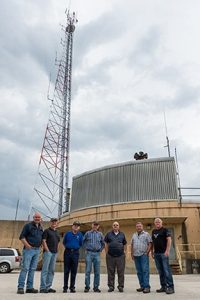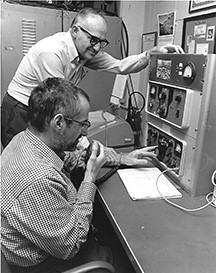Jay VonOsinski spent his entire three weeks of vacation in 2005 performing volunteer damage assessment for the Red Cross in New Orleans after Hurricane Katrina.
Argonne’s Amateur Radio Club marks its 60th year in 2018. The club’s transmitter shares space on the tower atop the ZGS hill.
VonOsinski, a beamline systems engineer who works for Northwestern University at Argonne, joined a response technology team that chronicled the wreckage using amateur radio equipment for communications.
Along the way VonOsinski met a group from the American Red Cross in Chicago that used similar equipment. The members recommended he get an amateur ham radio license and check out Argonne’s own amateur radio club.
When he returned to Argonne, VonOsinski met Tim Smith, a club member and engineer who had spent his vacation using ham radios to coordinate shelter logistics for the Red Cross in Pass Christian, MS, a town almost entirely destroyed by Katrina. “Once Jay and I realized we had been down there at that time and gone through that experience, he joined the club,” Smith said. “Funny how people’s paths cross.”
After his experience in New Orleans, VonOsinski said, he couldn’t resist.
“It’s all about responsible communication,” he said. “When cell phones go down, how do you communicate? You put up antennas and communicate the old way with radios.”
In this 1984 photo taken at the Argonne Radio Club station, Charles Cohn talks while Bill Karraker watches. Cohn occasionally used this high-frequency transceiver during lunch to talk with other amateurs sometimes half way around the world.
Today VonOsinski and Smith are among 45 dues-paying members of the Argonne Amateur Radio Club, which is celebrating its 60th anniversary this year as one of the longest standing clubs at the laboratory.
The AARC, which promotes amateur radio and emergency communications, hosts a variety of events and provides its W9ANL repeater, a combination receiver and transmitter, for use by amateur operators in the lab’s vicinity. Users do not need to work at Argonne to join the club.
“One of the charter reasons for the club is to get people interested and get them registered,” said Smith, now club secretary. “It’s a great hobby, but it’s also today very important to keep our abilities to communicate in disasters. The club has a rich history of contributing to Argonne’s office of emergency management for training and drills.”
AARC was founded in 1958 by nine Argonne employees, including Emil Martinec, a mechanical engineer in the reactor division, who shared a common interest in radios. Martinec remained a member until he retired in 1990.
“I was a radio operator in the military and I found there were other people at Argonne who had radio experience,” said Martinec, who arrived at Argonne in 1957. “We decided it would be fun, so we founded the club. I enjoyed the camaraderie.”
The original club operated in a “rag tag” manner until formally organizing in 1960, said Smith, also the club’s public information officer and de facto historian, who retired from Argonne as an electrical engineer at the Advanced Photon Source in 2013.
Martinec served as president in 1960, when the club began issuing newsletters, gained affiliation with the American Radio Relay League, obtained its first call name, and was featured in the Argonne News.
In 1965 the club erected the Chicago area’s first 2-meter repeater, named for the wavelength of its radio signal on the Very High Frequency band and able to reinforce the signal of low-power radios from one to two miles to 20 miles or more.
Two years later, using a combination of more sophisticated equipment on the High Frequency band, cofounder Norm Frigerio reported making contact inside the Soviet Union on a regular basis.
In 1980, the club made local history when Argonne-West in Idaho made contact with the Lemont lab on the 20-meter shortwave band.
With a new repeater and a push for membership, the club staged a demonstration of amateur radio capabilities at Hinsdale South High School in 1982, the same year Argonne was invited by ARRL to serve as a special event station to commemorate the 40th anniversary of the first controlled nuclear reaction.
“The club was enthusiastic about getting new people, especially young people,” Smith said.
AARC membership is not all fun and demonstrations, however. In addition to designing, delivering and evaluating emergency training at the lab, club members have provided services in real-time incidents, Smith said.
When a cooling tower adjacent to the APS caught fire while welders were doing work about eight years ago, club members facilitated communication with firefighters in the field, he said.
As president in 2012, Smith introduced EchoLink on the club’s repeater, allowing operators to link their PCs and smartphones to thousands of other stations via the internet.
To celebrate its anniversary, the club is working to regain its affiliation with the ARRL and is planning a Field Day in June. Field Day, ARRL’s annual “open house,” features more than 40,000 operators across North America demonstrating amateur radio’s “science, skill and service to our communities and the nation.”
Slated for June 23-24, Field Day requires participants to set up in open areas and provide their own power. The challenge is to make as many verifiable contacts as possible in 24 hours.
“Some do solar power, some do batteries, some even do fuel cell stuff,” VonOsinski said. “Some people are nuts about this. It could be just guys in a tent with a pretty good radio, taking turns running the radio for an hour. You get visitors to come in and you get points for that.”
More information about the club and membership may be obtained at [email protected]
— Phil Rockrohr



